White Balance
White balance ensures that white objects appear white, regardless of the color of the light source. The default setting (j) is recommended with most light sources. If the desired results cannot be achieved with auto white balance, choose another option as described below.
White balance can be selected using the White balance items in the i menu and the photo and movie shooting menus (0 White Balance, White Balance, White Balance).
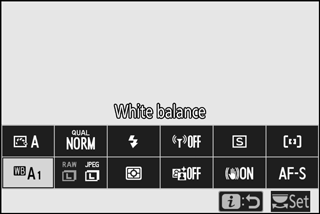
At default settings, white balance can also be selected by holding the Fn1 button and rotating the main command dial (0 The Function Buttons (Fn1 and Fn2)).
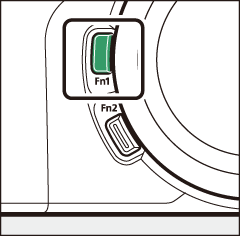
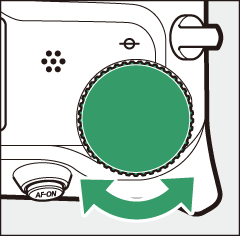
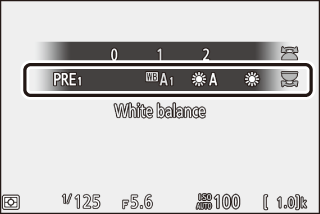
When 4 (Auto), I (Fluorescent), K (Choose color temperature), or L (Preset manual) is selected, you can choose a sub-option by holding the Fn1 button and rotating the sub-command dial.

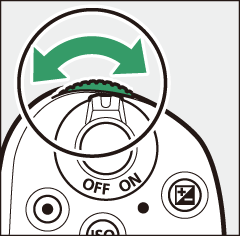
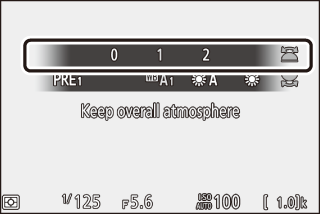
| Option | K * | Description | ||
|---|---|---|---|---|
| 4 | Auto | White balance is adjusted automatically for optimal results with most light sources. When an optional flash unit is used, white balance will be adjusted according to the lighting produced by the flash. | ||
| Keep white (reduce warm colors) | 3500–8000 | Eliminate warm color cast produced by incandescent lighting. | ||
| Keep overall atmosphere | Partially preserve warm color cast produced by incandescent lighting. | |||
| Keep warm lighting colors | Preserve warm color cast produced by incandescent lighting. | |||
| D | Natural light auto | 4500–8000 | When used under natural light, this option produces colors closer to those seen by the naked eye. | |
| H | Direct sunlight | 5200 | Use with subjects lit by direct sunlight. | |
| G | Cloudy | 6000 | Use in daylight under overcast skies. | |
| M | Shade | 8000 | Use in daylight with subjects in shade. | |
| J | Incandescent | 3000 | Use under incandescent lighting. | |
| I | Fluorescent | Use under fluorescent lighting; choose bulb type according to light source. | ||
| Sodium-vapor lamps | 2700 | |||
| Warm-white fluorescent | 3000 | |||
| White fluorescent | 3700 | |||
| Cool-white fluorescent | 4200 | |||
| Day white fluorescent | 5000 | |||
| Daylight fluorescent | 6500 | |||
| High temp. mercury-vapor | 7200 | |||
| 5 | Flash | 5400 | Use with studio strobe lighting and other large flash units. | |
| K | Choose color temperature | 2500–10,000 | Choose color temperature from list of values or by holding Fn1 button and rotating sub-command dial. | |
| L | Preset manual | — | Measure white balance for subject or light source (press and hold Fn1 button to enter direct measurement mode, 0 Preset Manual), copy white balance from existing photograph, or choose existing value by holding Fn1 button and rotating sub-command dial. | |
Color temperature. All values are approximate and do not reflect fine-tuning (if applicable).
D (“Natural Light Auto”)
D (Natural light auto) may not produce the desired results under artificial light. Choose 4 (Auto) or an option that matches the light source.
Studio Flash Lighting
4 (Auto) may not produce the desired results with large studio flash units. Use preset white balance or set white balance to 5 (Flash) and use fine-tuning to adjust white balance.
White Balance Fine-Tuning
At settings other than Choose color temperature, white balance can be fine-tuned using the White balance items in the i menu and the photo and movie shooting menus (0 Fine-Tuning White Balance).
4 (“Auto”)
The photo info for pictures shot using auto white balance lists the color temperature selected by the camera at the time the picture was taken. You can use this as reference when choosing a value for Choose color temperature. To view shooting data during playback, go to Playback display options in the playback menu and select Shooting data.
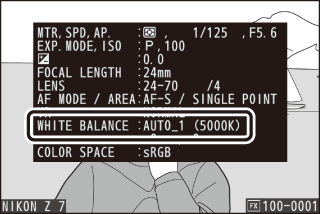
Color Temperature
The perceived color of a light source varies with the viewer and other conditions. Color temperature is an objective measure of the color of a light source, defined with reference to the temperature to which an object would have to be heated to radiate light in the same wavelengths. While light sources with a color temperature in the neighborhood of 5000–5500 K appear white, light sources with a lower color temperature, such as incandescent light bulbs, appear slightly yellow or red. Light sources with a higher color temperature appear tinged with blue.
“Warmer” (redder) colors
“Cooler” (bluer) colors

In general, choose lower values if your pictures have a red cast or to intentionally make colors colder, higher values if your pictures are tinged blue or to intentionally make colors warmer.
